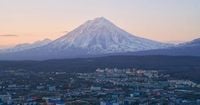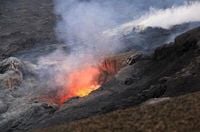On the morning of October 4, 2025, the remote and rugged Kamchatka Peninsula in Russia bore witness to a spectacular and alarming display of nature’s power. The Kronotsky volcano, one of the region’s most iconic and formidable peaks, erupted in dramatic fashion, sending a dense plume of ash soaring 9.2 kilometers (over 30,000 feet) into the sky. According to multiple reports from local authorities and international news agencies such as Xinhua and TASS, the ash plume stretched approximately 85 kilometers to the south and southeast of the volcano, casting a shadow—both literal and figurative—over the surrounding wilderness and communities.
The eruption, which occurred at 11:50 a.m. local time (2350 GMT on October 3), prompted the Kamchatka Volcanic Eruption Response Team to issue a red aviation color code—the highest level of alert for air traffic. This urgent warning signaled a significant hazard not only for local flights but also for international air routes that often traverse the vast expanse of Russian airspace. With the ash cloud drifting tens of kilometers from its source, pilots and airlines were forced to reevaluate their flight paths, and authorities scrambled to get the word out to anyone living or traveling in the region.
"A red aviation alert has been issued, signaling high risk to both domestic and international air traffic," Xinhua reported, echoing the gravity of the situation. Kronotsky itself sits about 225 kilometers from Petropavlovsk-Kamchatsky, the regional capital, and just 10 kilometers east of the pristine Lake Kronotskoye—a stark reminder of how close this raw geological power lies to human settlements and natural landmarks.
But what makes this eruption even more remarkable is the broader context in which it occurred. As noted by the Kamchatka Volcanic Eruption Response Team on its official Telegram channel, this event comes on the heels of an extraordinary sequence of volcanic activity across the peninsula. Earlier in 2025, a total of six volcanoes erupted in Kamchatka, a phenomenon that has left scientists both fascinated and concerned.
“According to our data, the last time such widespread volcanic activity occurred in Kamchatka was in 1737, following a magnitude-9 earthquake,” said Alexey Ozerov, director of the Institute of Volcanology and Seismology of the Far Eastern Branch of the Russian Academy of Sciences, in an interview with TASS. Ozerov went on to suggest that the region’s “sleeping giants” may have been reawakened by a powerful seismic event that struck on July 30, 2025. The connection between earthquakes and volcanic eruptions is well documented, but the scale and timing of these recent events have set the scientific community abuzz.
For those who have spent their lives studying Kamchatka’s volatile landscape, the recent uptick in activity is nothing short of extraordinary. Yury Demyanchuk, head of the volcanology station in the village of Klyuchi, offered a sobering perspective based on his decades of experience. “On Krasheninnikov Volcano, both summit and central eruptions have begun simultaneously, which may indicate intense internal seismic processes. As for Kambalny Volcano, I last worked on it in 1979. While it has been quiet for decades, it should not be considered extinct,” Demyanchuk explained, as quoted by TASS. He also noted that the previous eruption of Krasheninnikov likely occurred in the 15th century, its story told only by layers of ancient volcanic ash.
These insights underscore just how dynamic—and unpredictable—the Kamchatka Peninsula can be. Stretching across Russia’s Far East, this region is home to more than 300 volcanoes, 29 of which are considered active. The peninsula’s location along the “Ring of Fire,” a vast zone of seismic and volcanic activity encircling the Pacific Ocean, makes it one of the most geologically active places on Earth. While eruptions are not uncommon, the simultaneous awakening of so many volcanoes is a rare event, one that has not been seen for nearly three centuries.
Local authorities have responded to the latest eruption with a mix of caution and urgency. Residents and visitors have been urged to stay well away from all active volcanoes, as the risk of further eruptions or associated hazards—such as ashfall, landslides, and pyroclastic flows—remains high. “Authorities are warning residents and visitors to stay away from the active volcanoes,” reported Xinhua, emphasizing the seriousness of the situation.
The impact of volcanic ash is not limited to the immediate vicinity of the eruption. Ash clouds can travel hundreds of kilometers, disrupting air travel, contaminating water supplies, damaging crops, and posing significant health risks to people and animals. For airlines, the presence of ash in the atmosphere is particularly dangerous, as it can cause jet engines to fail and severely reduce visibility. The red aviation alert serves as a stark reminder of these dangers, prompting swift action from aviation authorities and meteorological agencies alike.
Meanwhile, the eruption at Kronotsky has drawn the attention of volcanologists and disaster response teams from around the world. The Kamchatka Volcanic Eruption Response Team continues to monitor the situation closely, providing updates on the ash plume’s movement and potential impacts. Satellite imagery and ground-based observations are being used to track the eruption’s progress, while scientists analyze seismic data in an effort to predict what might come next.
For many in Kamchatka, however, the eruption is a reminder of the peninsula’s untamed beauty and ever-present risks. The region’s volcanoes have shaped its landscape for millennia, creating fertile soils, dramatic mountains, and hot springs that attract tourists and researchers alike. But they have also brought destruction and uncertainty, forcing communities to adapt and remain vigilant in the face of nature’s unpredictability.
Interestingly, halfway around the world, another volcano was making headlines just a day earlier. On October 3, 2025, Hawaii’s Kilauea volcano was observed shooting lava 1,300 feet high, according to reports. While the circumstances and locations differ, these eruptions serve as a powerful reminder that Earth’s geological forces remain as active and awe-inspiring as ever.
As the ash settles over Kamchatka and scientists continue to unravel the mysteries behind this year’s volcanic surge, one thing is clear: the story of the peninsula’s “sleeping giants” is far from over. With each eruption, the landscape is reshaped, and the world is reminded of the delicate balance between human life and the restless forces beneath our feet.

